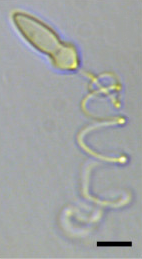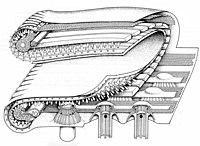
A flagellate is a cell or organism with one or more whip-like appendages called flagella. The word flagellate also describes a particular construction characteristic of many prokaryotes and eukaryotes and their means of motion. The term presently does not imply any specific relationship or classification of the organisms that possess flagella. However, the term "flagellate" is included in other terms which are more formally characterized.

The Percolozoa are a group of colourless, non-photosynthetic Excavata, including many that can transform between amoeboid, flagellate, and cyst stages.

The alveolates are a group of protists, considered a major clade and superphylum within Eukarya. They are currently grouped with the stramenopiles and Rhizaria among the protists with tubulocristate mitochondria into the SAR supergroup.

Cercozoa is a phylum of diverse single-celled eukaryotes. They lack shared morphological characteristics at the microscopic level, and are instead united by molecular phylogenies of rRNA and actin or polyubiquitin. They were the first major eukaryotic group to be recognized mainly through molecular phylogenies. They are the natural predators of many species of bacteria. They are closely related to the phylum Retaria, comprising amoeboids that usually have complex shells, and together form a supergroup called Rhizaria.

The metamonads are a large group of flagellate amitochondriate microscopic eukaryotes. Their composition is not entirely settled, but they include the retortamonads, diplomonads, and possibly the parabasalids and oxymonads as well. These four groups are all anaerobic, occurring mostly as symbiotes or parasites of animals, as is the case with Giardia lamblia which causes diarrhea in mammals.

David Joseph Patterson is a Northern Irish taxonomist specializing in protozoa and the use of taxonomy in biodiversity informatics.

Protozoa are a polyphyletic group of single-celled eukaryotes, either free-living or parasitic, that feed on organic matter such as other microorganisms or organic debris. Historically, protozoans were regarded as "one-celled animals".

Calkinsia is a monotypic genus of excavates comprising the single species Calkinsia aureus. It lives in low-oxygen seafloor environments. It is not classified in any of the three well-known groups of the Euglenozoa, but is placed in its own group, the Symbiontida. Some authors have classified Calkinsia alongside Postgaardi, but Postgaardi has not been studied well enough to test this hypothesis.
Carpediemonas is genus of Metamonada, and belongs to the group Excavata. This organism is a unicellular flagellated eukaryote that was first discovered in substrate samples from the Great Barrier Reef. Carpediemonas can be found in anaerobic intertidal sediment, where it feeds on bacteria. A feature of this species is the presence of a feeding groove, a characteristic of the excavates. Like most other metamonads, Carpediemonas does not rely on an aerobic mitochondrion to produce energy. Instead, it contains hydrogenosomes that are used to produce ATP. This organism has two flagella: a posterior one used for feeding on the substrate, and an anterior one that moves in a slower sweeping motion. Carpediemonas is assigned to the fornicates, where similar Carpediemonas-like organisms are used in researching the evolution within excavates. Although Carpediemonas is a member of the metamonads, it is unusual in the sense that it is free-living and has three basal bodies.
Trimastix is a genus of excavate protists, the sole occupant of the order Trimastigida. Trimastix are bacterivorous, free living and anaerobic. It was first observed in 1881 by William Kent. There are few known species, and the genus's role in the ecosystem is largely unknown. However, it is known that they generally live in marine environments within the tissues of decaying organisms to maintain an anoxic environment. Much interest in this group is related to its close association with other members of Preaxostyla. These organisms do not have classical mitochondria, and as such, much of the research involving these microbes is aimed at investigating the evolution of mitochondria.
Karyorelictea is a class of ciliates in the subphylum Postciliodesmatophora. Most species are members of the microbenthos community, that is, microscopic organisms found in the marine interstitial habitat, though one genus, Loxodes, is found in freshwater.

Myzozoa is a grouping of specific phyla within Alveolata, that either feed through myzocytosis, or were ancestrally capable of feeding through myzocytosis.

Amastigomonas is a genus of protists belonging to a lineage of biciliated zooflagellates known as Apusomonadida. It was first described in 1931 by Henri de Saedeleer. The current use of Amastigomonas is as a descriptive archetype, with no phylogenetic or taxonomic implications. The term "Amastigomonas-like" is used to refer to all apusomonads that lack the 'derived' characteristics of Apusomonas.
The kathablepharids are a group of heterotrophic flagellates (Protists) the first species of which was described by Skuja in 1939 as Kathablepharis phoenikoston,. His spelling was challenged because of non-compliance with botanical nomenclatural conditions, hence the alternative spelling Katablepharis. As the organism was heterotrophic and usually regarded as 'protozoan', and to favour stability, Skuja's original spelling has largely prevailed. With an anterior pocket and ejectisomes, the kathablepharids were thought initially to be cryptomonads. There were a variety of differences with Cryptomonas and other typical cryptomonads = cryptophytes, such as the thickness, length, and beat pattern of the flagella, their phagotrophic habitat, differences in the ejectisomes, and various features of their ultrastructure. The distinctive characteristics of the group were established from electron microscopical studies by Clay and Kugrens and Vørs. More recently they have been tentatively grouped with the chromalveolates, or distantly with the cryptophytes

Percolomonas is a genus of free-living flagellate Heteroloboseans, forming a clade with Stephanopogon.

Intramacronucleata is a subphylum of ciliates. The group is characterized by the manner in which division of the macronucleus is accomplished during binary fission of the cell. In ciliates of this subphylum, division of the macronucleus is achieved by the action of microtubules which are assembled inside the macronucleus itself. This is in contrast to heterotrich ciliates of the subphylum Postciliodesmatophora, in which division of the macronucleus relies on microtubules formed outside the macronuclear envelope.

Polykrikos is one of the genera of family Polykrikaceae that includes athecate pseudocolony-forming dinoflagellates. Polykrikos are characterized by a sophisticated ballistic apparatus, named the nematocyst-taeniocyst complex, which allows species to prey on a variety of organisms. Polykrikos have been found to regulate algal blooms as they feed on toxic dinoflagellates. However, there is also some data available on Polykrikos being toxic to fish.
Nanum is a genus of bicosoecids, a small group of unicellular flagellates, included among the heterokonts. It includes the sole species Nanum amicum, previously known as Nanos amicus but modified because the name Nanos was already occupied by a species of beetle.

Ultrastructural identity is a concept in biology. It asserts that evolutionary lineages of eukaryotes in general and protists in particular can be distinguished by complements and arrangements of cellular organelles. These ultrastructural components can be visualized by electron microscopy.
Thecamonadinae is a subfamily of heterotrophic protists. It is a monophyletic group, or clade, of apusomonads, a group of protozoa with two flagella closely related to the eukaryotic supergroup Opisthokonta. The subfamily contains two genera Chelonemonas and Thecamonas, which are found in marine habitats.
















